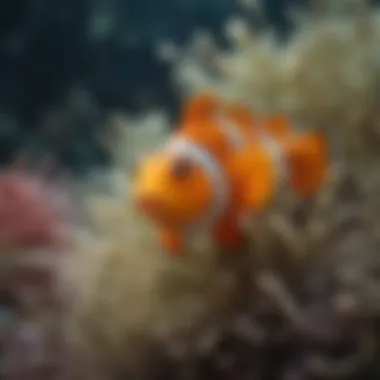Exploring Anemone Species: Characteristics and Ecology


Intro
Anemones are captivating marine organisms that command attention due to their unique presence within various underwater ecosystems. Belonging to the phylum Cnidaria, these creatures are often found swaying gracefully in ocean currents. Their bright colors, distinct shapes, and varied species make them a subject of interest for both enthusiasts and scientists alike. Understanding anemones is vital not only for ecological studies but also for conserving biological diversity.
Fascinating Facts About the Animal
Anemones are not merely aesthetically pleasing; they exhibit remarkable characteristics and abilities that contribute to their survival and adaptability in numerous marine environments.
Unique Characteristics
Anemones feature a simple body structure, primarily composed of a cylindrical polyp surrounded by tentacles. These tentacles contain specialized cells known as cnidocytes, which house nematocysts – stinging structures that enable anemones to capture prey and defend against threats. Their ability to exhibit a range of colors is often attributed to the presence of symbiotic algae or zooxanthellae, which provide them with nutrition and contribute to their vibrant hues.
Extraordinary Abilities
One of the most fascinating aspects of anemones is their ability to regenerate. In conditions where parts of their body are damaged, they can recreate lost tissues, ensuring their survival in harsh environments. This regenerative ability highlights their resilience. Additionally, anemones can adapt their feeding strategies based on available prey, utilizing their tentacles to ensnare small fish and zooplankton efficiently. This adaptability aids their longevity in diverse habitats.
"Anemones possess a captivating combination of beauty and survival instinct."
Behavior and Habitat
The behavior of anemones is closely linked to their habitats, which range from shallow coral reefs to deep-sea environments. Understanding their behavior and habitat is crucial for appreciating their ecological roles.
Natural Habitats
Anemones thrive in various marine environments, including rocky substrates, sandy bottoms, and coral reefs. Their distribution allows them to share habitats with a myriad of marine life, from clownfish to sea turtles. Some species even live in symbiotic relationships, providing mutual benefits.
Social Structures
Anemones are generally solitary animals, but certain species exhibit social behaviors. For example, clownfish find refuge among anemone tentacles, and in return, they offer protection against predators. This intricate relationship exemplifies the interconnectedness within marine ecosystems and showcases how species can cooperate for mutual survival.
Recent Scientific Discoveries
Recent advancements in marine biology have provided new insights into anemone species, uncovering their complex biology and ecological interactions.
Latest Research Findings
Studies have focused on how anemones respond to environmental stressors such as climate change and ocean acidification. Research indicates that some species show a remarkable resilience, while others may face significant threats due to rapid environmental changes.
Breakthroughs in Animal Biology
The application of genomic techniques has allowed scientists to delve deeper into anemone biology. Discoveries about their genetic makeup have uncovered fascinating evolutionary adaptations that enhance their survival, offering a glimpse into their ancient lineage among marine organisms.
Cultural Significance
Beyond their biological importance, anemones have made their mark in human culture, influencing art and folklore.
Animals in Folklore
In various cultures, anemones symbolize beauty and fragility. Their presence in folklore often represents resilience and the delicate balance of life, reflecting the human connection with the natural world.
Influence on Art and Literature
Artists have drawn inspiration from the stunning visuals of anemones for centuries. The contrast of colors and their unique shapes have made them popular subjects in paintings and literature, reminding us of the beauty found in marine environments.


In summary, the exploration of anemones not only enriches our understanding of marine biodiversity but also emphasizes their significance in conservation and ecological studies. As they continue to inhabit our oceans, their unique characteristics and relationships with other marine organisms remain a vital topic for ongoing research.
Intro to Anemones
Anemones are captivating creatures that play a critical role in marine ecosystems. Understanding them is vital for both scientific and environmental discussions, especially considering their connections to biodiversity and conservation efforts. Anemones are unique, soft-bodied organisms often found in diverse aquatic environments. They belong to the phylum Cnidaria, which also includes jellyfish and corals. This classification emphasizes their biological significance and complexity.
The importance of studying anemones goes beyond mere academic interest. They are fundamental in marine food webs, acting as both predators and prey. Their vibrant colors and varied forms attract attention, making them popular in aquariums. Anemones also have symbiotic relationships with other marine organisms, such as clownfish. This dynamic interaction highlights their ecological role and demonstrates how species interconnect within their habitats.
Establishing comprehensive knowledge about anemones allows for better conservation practices. As changes in climate and habitat destruction impact marine life, anemones often serve as indicators of ecosystem health. They can illustrate broader environmental changes and signal necessary actions to protect marine biodiversity. Therefore, the introduction to anemones provides a rich context for understanding their biological features and the environmental challenges they face today.
Overview of Anemone Biology
Anemones exhibit fascinating biological characteristics. These organisms are radially symmetrical, allowing them to interact equally from all directions. They possess a simple body structure, primarily consisting of a central column called the column and a mouth surrounded by tentacles. The tentacles contain specialized cells called nematocysts. These cells can sting and capture prey, which usually includes small fish, zooplankton, and other tiny marine organisms.
Anemones can reproduce both sexually and asexually. Sexual reproduction often involves the release of gametes into the water, leading to the formation of larvae. Asexual reproduction can occur through budding or fission, where an individual splits to create two separate organisms. This feature enables rapid population growth under favorable conditions. Anemones also have varying lifespans, often living several years or even decades, depending on the species and environmental conditions.
Historical Significance of Anemones
Historically, anemones have been regarded with intrigue and reverence in various cultures. Ancient civilizations utilized them as food sources due to their abundance along coastlines. They also appeared in art and literature, symbolizing the beauty of underwater life.
In a scientific context, the study of anemones has contributed to a broader understanding of marine biology and environmental science. Research on their physiology and ecosystems can yield insights into the evolutionary processes that shape marine life. Moreover, the discovery of symbiotic relationships between anemones and clownfish has challenged previous conceptions of mutualism in nature. This relationship highlights the complexities of marine interactions, offering valuable lessons for conservation strategies in today's rapidly changing environments.
Through this exploration into their biology and history, a multidimensional perspective on anemones emerges, revealing their significance beyond their simple appearance.
Types of Anemones
Understanding the various types of anemones is crucial for comprehending their ecological niches and their roles in marine environments. Each species possesses unique characteristics that contribute to both biodiversity and the functionality of coral reefs. Additionally, anemones have distinct interactions with other marine organisms, which further underscores their importance in marine ecosystems. By examining these types, one can also appreciate their varying requirements for habitat and care, especially in aquaculture and aquarium settings.
Giant Green Anemone
The Giant Green Anemone, Anthopleura xanthogrammica, is notable for its vibrant green hue, primarily caused by the presence of symbiotic algae. These anemones can be quite large, reaching up to 12 inches in diameter. Their presence is often a sign of a healthy coastal ecosystem. The Giant Green Anemone is typically found in tide pools and rocky intertidal zones along the Pacific Coast of North America. Its size and coloration not only attract tourists but also serve as a critical habitat provider for various marine species.
Bubble-tip Anemone
The Bubble-tip Anemone, scientifically known as Entacmaea quadricolor, is famous for its distinctive bubble-like tips. This species is a popular choice in the aquarium trade due to its manageable size, typically reaching around 5 to 6 inches. It thrives in a variety of conditions but prefers moderate water movement and light. Its adaptability and ease of care make it a favorite among hobbyists, while its role as a host for clownfish enhances its ecological significance.
Rock Anemone
The Rock Anemone, or Anthopleura elegantissima, can often be identified by its striking color variations, which include hues of purple, green, and pink. These anemones are commonly found in rocky substrates along the Pacific Coast. They can vary significantly in size but usually do not exceed 8 inches in diameter. The Rock Anemone plays an essential role in coastal ecosystems, providing shelter to smaller marine animals and contributing to the biodiversity of its habitat.
Striped Anemone
Gongylactis falciformis, also known as the Striped Anemone, features long, slender tentacles that give it a unique appearance. This species primarily resides in shallow waters, where it can blend into the coral or rock substrates. The Striped Anemone can grow up to 10 inches tall and demonstrates a fascinating feeding behavior, extending its tentacles to capture plankton and small fish. Its striking appearance makes it a visually appealing component of marine environments, attracting divers and marine enthusiasts alike.
Condylactis Anemone
The Condylactis Anemone, or Condylactis gigantea, is known for its long, flowing tentacles and vibrant colors. Often found in warm waters, this species can grow to about 12 inches in diameter and is commonly seen in Caribbean reefs. The Condylactis Anemone is important not only for its beauty but also for its role as a habitat for various fish species, particularly those in symbiotic relationships. Its adaptability to a range of environments demonstrates the resilience of certain anemone species.
Magnificent Sea Anemone
The Magnificent Sea Anemone, Heteractis magnifica, is aptly named for its impressive size and striking appearance. It can reach up to 27 inches in diameter, making it one of the largest sea anemones. This species is often found in deeper waters of coral reefs and is notable for its mutualistic relationship with certain clownfish species. The mutualism enhances the anemone's protection while providing the clownfish with a safe haven from predators. Awareness of the Magnificent Sea Anemone's habitat and behavior is vital for marine conservation efforts.
Painted Anemone


Actinia meiostoma, known as the Painted Anemone, is characterized by its colorful appearance, often sporting a mix of reds, yellows, and purples. This species is typically found in sandy or muddy substrates and can grow to a modest size of about 6 inches. The Painted Anemone is primarily found along the Atlantic Coast. Its vibrant colors and patterns contribute to the aesthetic value of marine ecosystems, playing a role in attracting various marine species for grazing or shelter.
Tube Anemone
The Tube Anemone, or Pachycerianthus fischeri, differs significantly from other anemones because it resides in a tube-like structure. This adaptation provides the anemone with protection while allowing it to extend its tentacles to capture food. Tube Anemones are typically found in deep, sandy substrates where they can remain safe from predators. Understanding the behavior and habitat of Tube Anemones is critical, particularly in relation to their ecological role in the sedimentary environments where they thrive.
Ecological Role of Anemones
Anemones play a critical role in marine ecosystems. Their ecological importance derives from various interactions they have with other organisms and their contributions to the health of the environment. Understanding these roles adds depth to our comprehension of marine biodiversity and conservation strategies. Anemones are not merely beautiful organisms; they hold numerous benefits for their environment.
Symbiosis with Clownfish
One of the most well-known relationships in marine biology is that of anemones and clownfish. Clownfish are immune to the sting of anemones, which enables them to live among the anemone's tentacles. This symbiotic relationship offers advantages for both parties involved.
For anemones, clownfish provide protection from predators. In return, clownfish benefit from the anemone's safety, as well as access to food scraps that drift by. This mutualism establishes a balance, enhancing the survival of both species. Moreover, this unique partnership highlights the intricate interdependence present in ecological systems. Anemones thus serve as a crucial habitat for clownfish, demonstrating their essential role in marine biodiversity.
Impact on Marine Biodiversity
Anemones contribute significantly to the biodiversity of their environments. They create habitats that support various marine organisms. Many creatures, such as small fish, shrimp, and other invertebrates, live in and around anemones. This habitat complexity fosters a greater variety of species compared to areas devoid of anemones. The presence of anemones can influence species distribution, abundance, and community structure.
Anemones, as structural entities in the ocean, facilitate interactions that drive biodiversity.
Their ability to host different species makes them essential players in marine ecosystems. Furthermore, some anemone species can reproduce both sexually and asexually. This versatile reproductive strategy allows for population resilience and adaptability in changing environments.
Feeding Habits
Anemones are carnivorous and have unique feeding habits that involve capturing prey with their tentacles. Their tentacles are equipped with specialized cells called nematocysts, which release toxins that paralyze or kill unsuspecting prey. Common prey for anemones includes small fish, zooplankton, and other small marine creatures. This predatory behavior contributes to the balance of marine food webs.
Furthermore, anemones can also benefit from symbiotic relationships with zooxanthellae, algae that live within their tissues. This relationship is particularly notable in some tropical species. The algae provide the anemones with nutrients through photosynthesis, creating a unique form of nutrient cycling in their ecosystems. Through both predation and symbiosis, anemones play a multifaceted role in nutrient dynamics and energy transfer, enriching their marine surroundings.
Habitat and Distribution
The habitat and distribution of anemones represent critical factors in understanding their biology and ecological contributions. These creatures inhabit diverse environments, from shallow tidal pools to deep ocean floors, showcasing their adaptability. Recognizing where different anemone species thrive can offer insights into their behavior, survival strategies, and interactions with other marine organisms.
Geographical Range
Anemones can be found in various oceans and seas worldwide. They predominantly reside in the warm regions along the coastlines of the Atlantic, Pacific, and Indian Oceans. Some species flourish near the coral reefs, while others inhabit rocky shores or sandy substrates. Specific anemones, like the Giant Green Anemone, often appear along the western coasts of North America, while the Magnificent Sea Anemone is typically found in the tropical waters of the Indo-Pacific region.
The geographical range of anemones is influenced by factors such as water temperature, salinity, and ocean currents. It is important to recognize that variations in these environmental conditions can dictate which species are found in a particular area.
Preferred Environmental Conditions
Anemones thrive in specific environmental conditions essential for their growth and reproduction. Generally, they prefer warmer waters, with many species inhabiting temperatures between 20°C to 28°C. Furthermore, salinity levels play a significant role; these organisms favor marine environments with stable salinity, usually around 35 parts per thousand.
Moreover, anemones require specific substrates to attach themselves, such as rocks, corals, or even the shells of larger marine animals. These substrates provide not only attachment but also protection from predators. Light levels also impact their habitat choices. Some anemones benefit from areas with moderate light, aiding in symbiotic relationships with photosynthetic organisms like zooxanthellae.
Understanding these habitat preferences is crucial for conservation efforts, as changes in climate and human activities can alter suitable environments for these delicate creatures.
"Habitat preferences and geographical distribution are vital elements affecting both the survival and ecological roles of anemones in marine ecosystems."
Integrating knowledge about the habitats and distribution patterns of anemones aids in highlighting their importance within the food web and emphasizes the need for safeguarding their environments.
Anemones in Aquaculture


Anemones play a significant role in aquaculture, enhancing both biodiversity and economic viability. This section explores various dimensions of their cultivation and utilization in aquaculture, focusing on its commercial value and the challenges faced in farming these captivating marine organisms.
Commercial Value
Anemones have considerable commercial value, particularly in the aquarium trade. Their vibrant colors and diverse forms can attract hobbyists and marine enthusiasts alike. Species such as the Bubble-tip Anemone are often sought after for their fascinating appearance and symbiotic relationships with clownfish. This relationship increases their appeal in home aquariums, adding to the economic incentive for their cultivation.
The demand for anemones extends beyond the hobbyist market. Some species are harvested for their potential use in medical research, especially in studies related to their stinging cells, known as nematocysts. These specialized cells can lead to advancements in pain management and various treatments. Moreover, understanding their unique biology can contribute to broader marine ecological research, making them valuable from an academic standpoint.
"The economic importance of anemones transcends mere aesthetics; their role in scientific studies presents far-reaching implications for marine biology."
In addition, anemones also provide ecosystem services. They assist in controlling algal growth, impacting water quality and benefiting nearby marine life. Their ecological roles enhance their marketability, as aquaculturists recognize the importance of maintaining healthy aquatic environments.
Cultivation Challenges
While the commercial potential for anemones is promising, several challenges complicate their cultivation. A primary concern lies in their specific environmental needs. Anemones require stable temperature, salinity, and lighting conditions to thrive. This requirement can make large-scale farming a complex endeavor, as fluctuations in water quality can stress these organisms and inhibit growth.
In terms of breeding, many anemones exhibit low reproductive rates in captivity. Natural reproduction often involves factors that are challenging to replicate, such as specific light cycles and substrate conditions. These nuances in their biology make it difficult for aquaculturists to establish sustainable populations in a farming environment.
Moreover, diseases can emerge in crowded aquaculture settings. Anemones are susceptible to infections that can decimate stocks rapidly. Thus, ensuring proper biosecurity measures and maintaining optimal water conditions are essential yet demanding aspects of successful anemone farming.
To summarize, while anemones show enormous potential for aquaculture applications, addressing these cultivation challenges is crucial for maximizing their commercial value and ensuring their sustainability in marine ecosystems. Their dual roles as attractive organisms for aquariums and significant contributors to ecological balance further underline the need for thoughtful practices in their aquaculture.
Conservation Status
Understanding the conservation status of anemones is vital for appreciating their role in marine ecosystems and acknowledging the pressures they face. Anemones are not only fascinating organisms but also pivotal players in biodiversity. Their health reflects broader oceanic health, making their conservation a crucial aspect of marine biology. As human activities increasingly threaten marine environments, knowing the status of these species can help guide conservation strategies effectively.
Threats to Anemones
Anemones encounter numerous threats largely driven by human activities. Here are key elements influencing their survival:
- Habitat Destruction: Coastal development, pollution, and climate change result in habitat degradation. Anemones thrive in specific environments such as coral reefs. When these habitats are compromised, the anemones have nowhere to go.
- Overfishing: Many anemones interact closely with fish species, including clownfish. Overfishing these companion species can disrupt the delicate balance necessary for anemones’ survival.
- Climate Change: Rising ocean temperatures and ocean acidification impact anemone populations. Heat stress can lead to bleaching, diminishing their capacity to thrive and reproduce.
- Invasive Species: Non-native species can outcompete or prey on anemones. These invasions can change local ecosystems, often detrimentally impacting indigenous anemone populations.
"Monitoring and addressing these threats is essential for preserving anemone diversity in our oceans."
Conservation Efforts
Efforts to conserve anemones focus on rebuilding their habitats and stabilizing the ecosystems they support. Important conservation actions include:
- Protected Areas: Establishing marine protected areas allows natural processes to occur without human interference. These zones provide safe havens for anemone populations and other marine life.
- Research and Monitoring: Ongoing studies are critical. Understanding anemone biology, including their life cycles and reproductive strategies, helps in developing effective conservation plans.
- Public Awareness: Educating the public about the importance of marine conservation can lead to increased support for protective measures. Campaigns emphasizing the ecological role of anemones can inspire communal efforts to safeguard their habitats.
- Legislation: Implementing policies that regulate fishing and pollution control is essential. Stronger laws can help reduce direct and indirect impacts on anemones and their ecosystems.
By combining these efforts, the hope is to stabilize and potentially increase anemone populations, contributing positively to the overall health of marine ecosystems.
Closure
The conclusion serves a vital function in this article, as it synthesizes the intricate details surrounding anemones and their roles within ecosystems. This section reiterates crucial insights about the diversity of anemone species and emphasizes their ecological, commercial, and conservation significance.
Summarizing Key Points
In this article, we have explored several essential themes:
- Biological Diversity: Anemones are not just simple organisms; they range from small species to large, intricate varieties, each with unique traits and habitats.
- Ecological Importance: Their role in marine environments is pivotal. They provide habitats for various marine species, notably clownfish, leading to symbiotic relationships that enhance biodiversity.
- Aquaculture and Conservation: Anemones are important in commercial aquaculture, but they face threats that necessitate concerted conservation efforts. Understanding these threats is crucial for the sustainability of their populations.
This reiteration of themes aids readers in grasping the multifaceted nature of anemones. By emphasizing their significance in biodiversity and their role in ecosystems, we underline why a holistic understanding of their biology and conservation is essential.
Future Directions for Research
Future research should focus on several key areas to deepen our comprehension of anemones:
- Genetic Studies: Investigating genetic variations among species can provide insights into their adaptability and evolutionary trends in response to changing marine environments.
- Impact of Climate Change: As global temperatures rise, studying how temperature variations affect anemone behavior and habitat will be crucial for conservation efforts.
- Aquaculture Innovations: Researching new methods for cultivating anemones sustainably could provide economic benefits while protecting wild populations.







